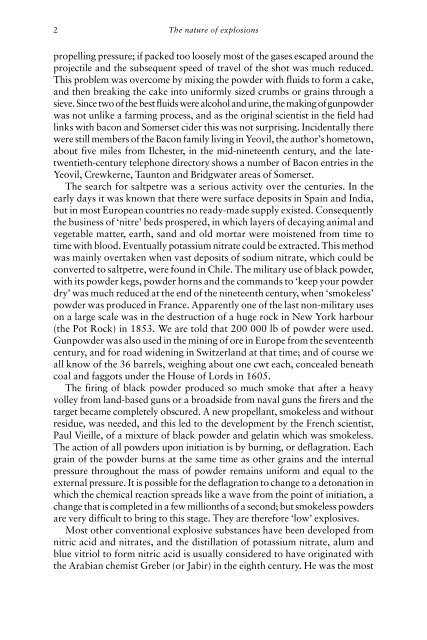A History of Research and a Review of Recent Developments
A History of Research and a Review of Recent Developments
A History of Research and a Review of Recent Developments
You also want an ePaper? Increase the reach of your titles
YUMPU automatically turns print PDFs into web optimized ePapers that Google loves.
2<br />
The nature <strong>of</strong> explosions<br />
propelling pressure; if packed too loosely most <strong>of</strong> the gases escaped around the<br />
projectile <strong>and</strong> the subsequent speed <strong>of</strong> travel <strong>of</strong> the shot was much reduced.<br />
This problem was overcome by mixing the powder with fluids to form a cake,<br />
<strong>and</strong> then breaking the cake into uniformly sized crumbs or grains through a<br />
sieve. Since two <strong>of</strong> the best fluids were alcohol <strong>and</strong> urine, the making <strong>of</strong> gunpowder<br />
was not unlike a farming process, <strong>and</strong> as the original scientist in the field had<br />
links with bacon <strong>and</strong> Somerset cider this was not surprising. Incidentally there<br />
were still members <strong>of</strong> the Bacon family living in Yeovil, the author’s hometown,<br />
about five miles from Ilchester, in the mid-nineteenth century, <strong>and</strong> the latetwentieth-century<br />
telephone directory shows a number <strong>of</strong> Bacon entries in the<br />
Yeovil, Crewkerne, Taunton <strong>and</strong> Bridgwater areas <strong>of</strong> Somerset.<br />
The search for saltpetre was a serious activity over the centuries. In the<br />
early days it was known that there were surface deposits in Spain <strong>and</strong> India,<br />
but in most European countries no ready-made supply existed. Consequently<br />
the business <strong>of</strong> ‘nitre’ beds prospered, in which layers <strong>of</strong> decaying animal <strong>and</strong><br />
vegetable matter, earth, s<strong>and</strong> <strong>and</strong> old mortar were moistened from time to<br />
time with blood. Eventually potassium nitrate could be extracted. This method<br />
was mainly overtaken when vast deposits <strong>of</strong> sodium nitrate, which could be<br />
converted to saltpetre, were found in Chile. The military use <strong>of</strong> black powder,<br />
with its powder kegs, powder horns <strong>and</strong> the comm<strong>and</strong>s to ‘keep your powder<br />
dry’ was much reduced at the end <strong>of</strong> the nineteenth century, when ‘smokeless’<br />
powder was produced in France. Apparently one <strong>of</strong> the last non-military uses<br />
on a large scale was in the destruction <strong>of</strong> a huge rock in New York harbour<br />
(the Pot Rock) in 1853. We are told that 200 000 lb <strong>of</strong> powder were used.<br />
Gunpowder was also used in the mining <strong>of</strong> ore in Europe from the seventeenth<br />
century, <strong>and</strong> for road widening in Switzerl<strong>and</strong> at that time; <strong>and</strong> <strong>of</strong> course we<br />
all know <strong>of</strong> the 36 barrels, weighing about one cwt each, concealed beneath<br />
coal <strong>and</strong> faggots under the House <strong>of</strong> Lords in 1605.<br />
The firing <strong>of</strong> black powder produced so much smoke that after a heavy<br />
volley from l<strong>and</strong>-based guns or a broadside from naval guns the firers <strong>and</strong> the<br />
target became completely obscured. A new propellant, smokeless <strong>and</strong> without<br />
residue, was needed, <strong>and</strong> this led to the development by the French scientist,<br />
Paul Vieille, <strong>of</strong> a mixture <strong>of</strong> black powder <strong>and</strong> gelatin which was smokeless.<br />
The action <strong>of</strong> all powders upon initiation is by burning, or deflagration. Each<br />
grain <strong>of</strong> the powder burns at the same time as other grains <strong>and</strong> the internal<br />
pressure throughout the mass <strong>of</strong> powder remains uniform <strong>and</strong> equal to the<br />
external pressure. It is possible for the deflagration to change to a detonation in<br />
which the chemical reaction spreads like a wave from the point <strong>of</strong> initiation, a<br />
change that is completed in a few millionths <strong>of</strong> a second; but smokeless powders<br />
are very difficult to bring to this stage. They are therefore ‘low’ explosives.<br />
Most other conventional explosive substances have been developed from<br />
nitric acid <strong>and</strong> nitrates, <strong>and</strong> the distillation <strong>of</strong> potassium nitrate, alum <strong>and</strong><br />
blue vitriol to form nitric acid is usually considered to have originated with<br />
the Arabian chemist Greber (or Jabir) in the eighth century. He was the most


